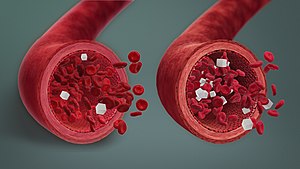Hypoglycemia
Hypoglycemia is when the level of blood sugar is lower than normal. A normal blood sugar level is about 70 to 100 milligrams per deciliter.
| Hypoglycemia | |
|---|---|
| Other names | Hypoglycaemia, hypoglycæmia, low blood glucose, low blood sugar |
 | |
| Hypoglycemia (left) and normal blood sugar concentration (right) | |
| Medical specialty | Endocrinology |
| Symptoms | Headache, blurred vision, shakiness, dizziness, weakness, tiredness, sweating, clamminess, fast heart rate, pounding heartbeat, nervousness or anxiety, hunger, nausea, pins and needles sensation, difficulty talking, confusion, unusual behavior, lightheadedness, pale skin color, seizures[1][2][3][4][5] |
| Complications | Loss of consciousness, death |
| Usual onset | Rapid[1] |
| Causes | Medications (insulin, glinides and sulfonylureas), sepsis, kidney failure, certain tumors, liver disease[1][6] |
| Diagnostic method | Whipple's triad: Symptoms of hypoglycemia, serum blood glucose level <70 mg/dL (3.9 mmol/L), and resolution of symptoms when blood glucose returns to normal[2] |
| Treatment | Eating foods high in simple sugars |
| Medication | Glucose, glucagon[1] |
| Frequency | In type 1 diabetics, mild hypoglycemia occurs twice per week on average, and severe hypoglycemia occurs once per year.[3] |
| Deaths | In type 1 diabetics, 6–10% will die of hypoglycemia.[3] |
All of the cells in the body need sugar to do their jobs and to survive. When a person does not have enough blood sugar, their body cannot work normally.
Hypoglycemia can cause many symptoms. Some common symptoms are:
- nausea
- feeling hungry
- sweating
- feeling sad
- feeling the heart pounding (heart palpitations)
Bad hypoglycemia can make a person act like they are drunk or have taken drugs. Very bad hypoglycemia can look like a stroke. Very bad (severe) hypoglycemia can cause serious medical problems (like seizures) or even death if it is not treated quickly enough.
Hypoglycemia can happen to anyone, at any age, but it usually happens in people who are diabetic. It is often a complication of treatment for diabetes with insulin or oral medications. The brain and other parts of the body cannot work without sugar.
Hypoglycemia is treated by raising the blood sugar levels back to normal. Often, a hypoglycemic person can bring their blood sugar levels back up by eating. In the worst cases, when the blood sugar is very low, hypoglycemia is treated by giving sugar water intravenously. In some cases, the liver is able to handle the issue by making glucose.[7][8]
References[change | change source]
- ↑ 1.0 1.1 1.2 1.3 Cite error: The named reference
NIH2008was used but no text was provided for refs named (see the help page). - ↑ 2.0 2.1 Cite error: The named reference
Cry2009was used but no text was provided for refs named (see the help page). - ↑ 3.0 3.1 3.2 Jameson JL, Kasper DL, Longo DL, Fauci AS, Hauser SL, Loscalzo J (2018). Harrison's principles of internal medicine (20th ed.). New York. ISBN 978-1-259-64403-0. OCLC 1029074059. Archived from the original on 29 August 2021. Retrieved 12 January 2022.
{{cite book}}: CS1 maint: location missing publisher (link) - ↑ Cite error: The named reference
Young_2016was used but no text was provided for refs named (see the help page). - ↑ American Diabetes Association (ADA). "Hypoglycemia (Low Blood Glucose)". www.diabetes.org. Archived from the original on 13 January 2022. Retrieved 12 January 2022.
- ↑ Cite error: The named reference
ReferenceAwas used but no text was provided for refs named (see the help page). - ↑ "Gluconeogenesis - an overview | ScienceDirect Topics". www.sciencedirect.com. Retrieved 2021-05-04.
- ↑ "Glycogenolysis | biochemistry". Encyclopedia Britannica. Retrieved 2021-05-04.
